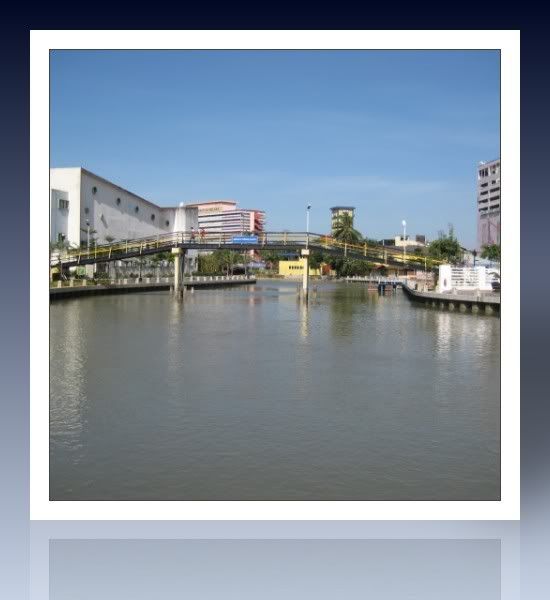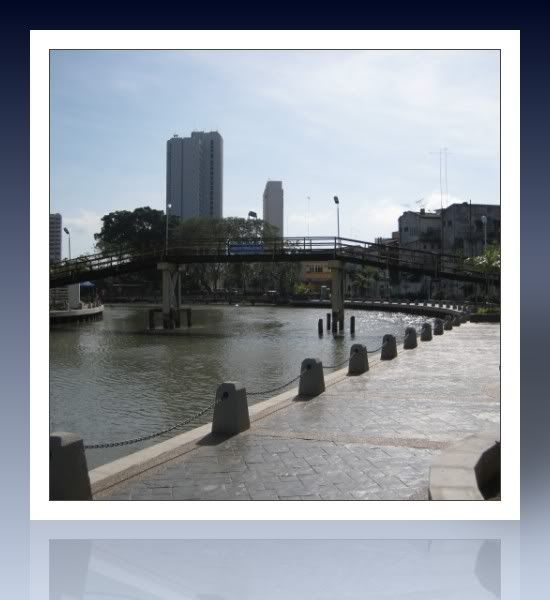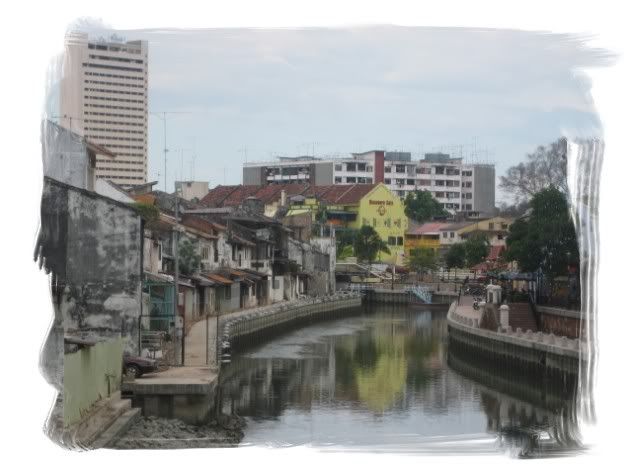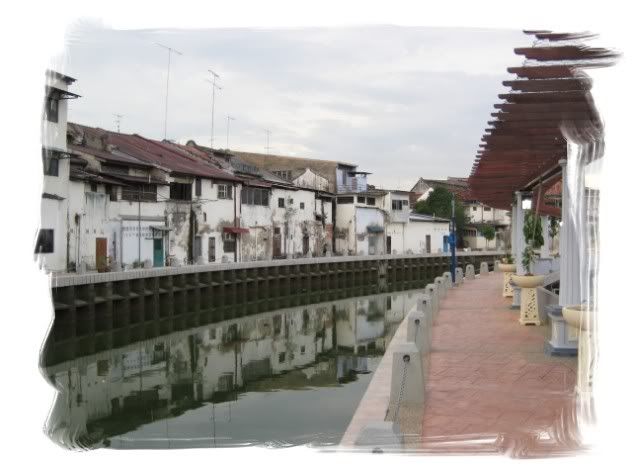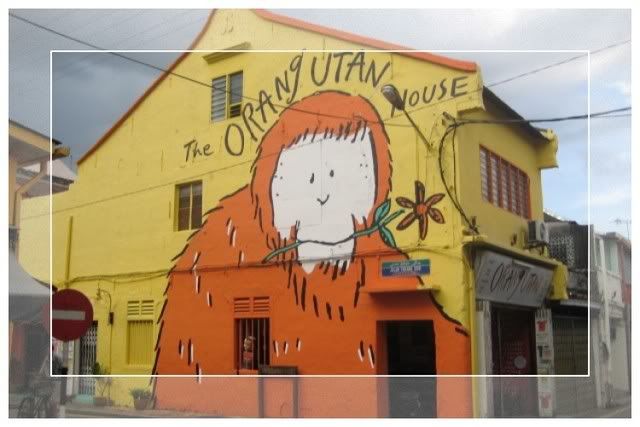Monday, June 17, 2013
Saturday, April 20, 2013
An age-old lesson in unity
An age-old lesson in unity

In Malacca’s old-world quarter: The Cheng Hoon Teng Temple in Jalan Tukang Emas, which was founded in 1645, is the oldest functioning Taoist temple in the country.
Houses of worship along Malacca’s Harmony Street a reminder of our forefathers’ mutual acceptance.
IF A street can knock some sense into politicians bent on using race and religion to divide the people, this is it.
It is combination of two roads — Jalan Tukang Emas (Goldsmith Street) and Jalan Tokong (Temple Street) — located in Malacca’s old-world quarter.
This stretch of road, referred to as ‘Harmony Street’ by the locals, is among the city’s must-see tourist attractions.
Here, ancient places of worship of the top three religions practised in the country are located in close proximity to each other and on the same side too.
The Sri Poyyatha Vinayagar Moorthi Temple, the Kampung Keling Mosque and the Cheng Hoon Teng Temple are grand testaments of religious pluralism practised in Malacca, the cradle of modern Malaysia.
They stand as splendid reminders of the old days when people had mutual acceptance and respect for each other, irrespective of ethnicity or religion.
The Sri Poyyatha Vinayagar Moorthi Temple, which has some elements of Dutch architecture, is the first to be seen if one comes from the direction of Jalan Tukang Besi (Blacksmith Street) and Lorong Hang Jebat junction where the iconic Orangutan House is.
Built in 1781 on a piece of land allocated by the Dutch, it is reputedly the oldest temple of its kind in Malaysia that is still in use.
It is linked to major festivals and remains very much a part of Hindu culture and practice in the city.
The temple is dedicated to Vinayagar, one of the 108 names of Ganesha — the elephant-faced Hindu deity.
Known as the ‘Lord of Obstacles and Remover of Obstacles’, his name is usually invoked at the beginning of all forms of worship and rituals.
As the deity is associated with luck, prosperity, well-being and wisdom, the Sri Poyyatha Vinayagar Moorthi Temple is also popular among locals of other races.
At the corner of Jalan Tukang Emas and Jalan Hang Lekiu stands the quaint Kampung Keling Mosque, built in 1748.
The mosque, built using timber on a square plan rather than the typical rectangular or hexagonal plan, has a curious blend of Eastern and Western features.
It has Corinthian columns, Chinese and Dutch decorative titles, arched windows, a verandah covering the prayer hall and a courtyard with a fountain-like pool for ablutions.
Like other old mosques in the city, its minaret and three-tier green roof look more like they belong on a pagoda than a mosque.
Although areas near the Malacca river in town is now regarded as Chinatown, the area stretching from Lorong Hang Jebat to Jalan Hang Lekiu was where Indians, primarily Tamils and Tamil Muslims lived.
The term keling referred to people from India and was not considered offensive or derogatory as it is deemed now.
It can be traced to the cultural and trading influence of the ancient Kalinga kingdom over the Malay Archipelago.
Kalinga was a powerful military and naval kingdom located in south-eastern India near modern-day Orissa and Andhra Pradesh. It was conquered by emperor Asoka in 262 BC.
Although later traders from India came from the Coromandel coast in south-east Tamil Nadu and from Gujarat in the north, Malays referred to the area as benua keling.
Castanheda, a Portuguese traveller who lived in Malacca between 1528 and 1538 wrote:
“In the northern part of the city live merchants who are known as Quelins (Klings). In this part, the town is much larger than any other. There are in Malacca, many foreign merchants, who I said before, live among themselves. They are Moors (Muslims) and pagans..... “
The third house of worship along Harmony Street is what the baba and nyonya call ‘Kebun Datok’ (Garden of the Gods) and Kwan Yin Teng (Goddess of Mercy Temple).
Cheng Hoon Teng (Temple of the Clear Clouds in Hokkien), the oldest functioning Taoist temple in the country, was founded in 1645 by local Chinese leader, Kapitan Tay Kie Ki alias Tay Hong Yong.
Its architecture and intricate details showcase the skills of migrant builders and craftsmen from China’s Fujian and Guangdong provinces.
The huge temple complex conforms the principles of feng shui, based on managing harmony with nature. Based on what has been written on granite tablets, the temple was laid out to ensure a view of the river and the high ground on either side.
The temple’s central altar is dedicated to Kuan Yin and to her left is Ma Choo or Ma Choe Poh deity, the patron deity of fishermen, sailors and sea travellers.
There are also altars dedicated to the goddess of birth, Kuan Kong (a Chinese general deified during the Sui Dynasty) and the gold-faced Pau Sen Ta Tek, the God of Welding.
In the early days, in addition to being a religious institution, Cheng Hoon Teng also served as the official administrative centre and court of justice of the Kapitans.
The British abolished the Kapitan system in 1824, but the leader of the Temple, now known as “Teng Choo”, assumed some of the Kapitan’s roles.
In 1824, the British abolished the Kapitan system and the leader of the temple, now known as “Teng Choo”, assumed some of the Kapitan’s responsibilities.
Later, a Board of Trustees was formed and the pioneers included Tun Sir Tan Cheng Lock, who also initiated the temple’s unique incorporation under an Act of Parliament.
The Cheng Hoon Teng Temple Incorporation Ordinance 1949, passed in Parliament in September 1949, effectively guaranteed the temple’s future and its role as guardian of the community’s spiritual and cultural heritage.
~News courtesy of The Star~

In Malacca’s old-world quarter: The Cheng Hoon Teng Temple in Jalan Tukang Emas, which was founded in 1645, is the oldest functioning Taoist temple in the country.
Houses of worship along Malacca’s Harmony Street a reminder of our forefathers’ mutual acceptance.
IF A street can knock some sense into politicians bent on using race and religion to divide the people, this is it.
It is combination of two roads — Jalan Tukang Emas (Goldsmith Street) and Jalan Tokong (Temple Street) — located in Malacca’s old-world quarter.
This stretch of road, referred to as ‘Harmony Street’ by the locals, is among the city’s must-see tourist attractions.
Here, ancient places of worship of the top three religions practised in the country are located in close proximity to each other and on the same side too.
The Sri Poyyatha Vinayagar Moorthi Temple, the Kampung Keling Mosque and the Cheng Hoon Teng Temple are grand testaments of religious pluralism practised in Malacca, the cradle of modern Malaysia.
They stand as splendid reminders of the old days when people had mutual acceptance and respect for each other, irrespective of ethnicity or religion.
The Sri Poyyatha Vinayagar Moorthi Temple, which has some elements of Dutch architecture, is the first to be seen if one comes from the direction of Jalan Tukang Besi (Blacksmith Street) and Lorong Hang Jebat junction where the iconic Orangutan House is.
Built in 1781 on a piece of land allocated by the Dutch, it is reputedly the oldest temple of its kind in Malaysia that is still in use.
It is linked to major festivals and remains very much a part of Hindu culture and practice in the city.
The temple is dedicated to Vinayagar, one of the 108 names of Ganesha — the elephant-faced Hindu deity.
Known as the ‘Lord of Obstacles and Remover of Obstacles’, his name is usually invoked at the beginning of all forms of worship and rituals.
As the deity is associated with luck, prosperity, well-being and wisdom, the Sri Poyyatha Vinayagar Moorthi Temple is also popular among locals of other races.
At the corner of Jalan Tukang Emas and Jalan Hang Lekiu stands the quaint Kampung Keling Mosque, built in 1748.
The mosque, built using timber on a square plan rather than the typical rectangular or hexagonal plan, has a curious blend of Eastern and Western features.
It has Corinthian columns, Chinese and Dutch decorative titles, arched windows, a verandah covering the prayer hall and a courtyard with a fountain-like pool for ablutions.
Like other old mosques in the city, its minaret and three-tier green roof look more like they belong on a pagoda than a mosque.
Although areas near the Malacca river in town is now regarded as Chinatown, the area stretching from Lorong Hang Jebat to Jalan Hang Lekiu was where Indians, primarily Tamils and Tamil Muslims lived.
The term keling referred to people from India and was not considered offensive or derogatory as it is deemed now.
It can be traced to the cultural and trading influence of the ancient Kalinga kingdom over the Malay Archipelago.
Kalinga was a powerful military and naval kingdom located in south-eastern India near modern-day Orissa and Andhra Pradesh. It was conquered by emperor Asoka in 262 BC.
Although later traders from India came from the Coromandel coast in south-east Tamil Nadu and from Gujarat in the north, Malays referred to the area as benua keling.
Castanheda, a Portuguese traveller who lived in Malacca between 1528 and 1538 wrote:
“In the northern part of the city live merchants who are known as Quelins (Klings). In this part, the town is much larger than any other. There are in Malacca, many foreign merchants, who I said before, live among themselves. They are Moors (Muslims) and pagans..... “
The third house of worship along Harmony Street is what the baba and nyonya call ‘Kebun Datok’ (Garden of the Gods) and Kwan Yin Teng (Goddess of Mercy Temple).
Cheng Hoon Teng (Temple of the Clear Clouds in Hokkien), the oldest functioning Taoist temple in the country, was founded in 1645 by local Chinese leader, Kapitan Tay Kie Ki alias Tay Hong Yong.
Its architecture and intricate details showcase the skills of migrant builders and craftsmen from China’s Fujian and Guangdong provinces.
The huge temple complex conforms the principles of feng shui, based on managing harmony with nature. Based on what has been written on granite tablets, the temple was laid out to ensure a view of the river and the high ground on either side.
The temple’s central altar is dedicated to Kuan Yin and to her left is Ma Choo or Ma Choe Poh deity, the patron deity of fishermen, sailors and sea travellers.
There are also altars dedicated to the goddess of birth, Kuan Kong (a Chinese general deified during the Sui Dynasty) and the gold-faced Pau Sen Ta Tek, the God of Welding.
In the early days, in addition to being a religious institution, Cheng Hoon Teng also served as the official administrative centre and court of justice of the Kapitans.
The British abolished the Kapitan system in 1824, but the leader of the Temple, now known as “Teng Choo”, assumed some of the Kapitan’s roles.
In 1824, the British abolished the Kapitan system and the leader of the temple, now known as “Teng Choo”, assumed some of the Kapitan’s responsibilities.
Later, a Board of Trustees was formed and the pioneers included Tun Sir Tan Cheng Lock, who also initiated the temple’s unique incorporation under an Act of Parliament.
The Cheng Hoon Teng Temple Incorporation Ordinance 1949, passed in Parliament in September 1949, effectively guaranteed the temple’s future and its role as guardian of the community’s spiritual and cultural heritage.
~News courtesy of The Star~
Labels:
Historical heritage,
Landmarks,
Malacca,
Places of Interest,
Tourism
Thursday, April 11, 2013
Historical city’s fascinating draw
Historical city’s fascinating draw

Art and technology: According to Tourism Melaka, this Melaka Sultanate Watermill has been recorded as the first and largest watermill in Malaysia. It was built in late 2007 and completed in March the next year.
MALACCA is the perfect stop for parents looking for an educational and fun trip for their young children.
Visiting the historical places there certainly makes history lessons for primary school pupils, in particular, more interesting.
Malacca, with its tourism slogan “Visit Historic Melaka Means Visit Malaysia” has to live up to the theme in several ways.
The first stop in Malacca should be the Padang Pahlawan or Warriors Field — the place where the proclaimation of independence was made by Malaysia’s first Prime Minister Tunku Abdul Rahman Putra Al-Haj.
Local and foreign tourists should spend some time — depending on their interest in history — to take a closer look at invaluable exhibits of the country’s journey; anything from relics and manuscripts to films and slides.
From the memorial, tourists can proceed to A Famosa, built by the Portuguese when they conquered Malacca in 1511.
While only the entrance to the fort remains today, it is certainly a crowd puller.
The old canon attracts young children, who enjoy getting photographed with it.
Foreign tourists have a preference for relics, and can be seen getting a closer look at these.
Another interesting place to learn more about Malacca’s rich history is the Maritime Museum Complex.
The complex, a life-size replica of the Portuguese ship Flor de Lamar in the 16th century, showcases Malacca’s maritime history and the golden age of the Malacca sultanate.
To rest their tired feet, tourists can take a ride on the Malacca River Cruise.
The picture-perfect scenery along the river include old shophouses, some turned into open air cafes that attracts foreign tourists who enjoy taking in the sights.
The clean environment complements the beautiful surroundings, especially the river.
Those tasked with managing various tourism spots in other states, including Perak, could perhaps learn from Malacca.
The 45-minute cruise also showcases the multicultural heritage of Malaysia through beautiful murals along the river bank. It is indeed a cruise not to be missed.
For MyKad holders, the ticket price for adults is RM10 and RM5 for children.
A half-day tour covers these few places in a leisurely pace.
The city was packed with tourists during the school holidays at the end of last month.
Besides being famous as a Unesco world heritage site, Malacca’s achievements in tourism show that there is so much potential in the country, which can be developed into a world-class product with proper planning and good vision.
~News courtesy of The Star~

Art and technology: According to Tourism Melaka, this Melaka Sultanate Watermill has been recorded as the first and largest watermill in Malaysia. It was built in late 2007 and completed in March the next year.
MALACCA is the perfect stop for parents looking for an educational and fun trip for their young children.
Visiting the historical places there certainly makes history lessons for primary school pupils, in particular, more interesting.
Malacca, with its tourism slogan “Visit Historic Melaka Means Visit Malaysia” has to live up to the theme in several ways.
The first stop in Malacca should be the Padang Pahlawan or Warriors Field — the place where the proclaimation of independence was made by Malaysia’s first Prime Minister Tunku Abdul Rahman Putra Al-Haj.
Local and foreign tourists should spend some time — depending on their interest in history — to take a closer look at invaluable exhibits of the country’s journey; anything from relics and manuscripts to films and slides.
From the memorial, tourists can proceed to A Famosa, built by the Portuguese when they conquered Malacca in 1511.
While only the entrance to the fort remains today, it is certainly a crowd puller.
The old canon attracts young children, who enjoy getting photographed with it.
Foreign tourists have a preference for relics, and can be seen getting a closer look at these.
Another interesting place to learn more about Malacca’s rich history is the Maritime Museum Complex.
The complex, a life-size replica of the Portuguese ship Flor de Lamar in the 16th century, showcases Malacca’s maritime history and the golden age of the Malacca sultanate.
To rest their tired feet, tourists can take a ride on the Malacca River Cruise.
The picture-perfect scenery along the river include old shophouses, some turned into open air cafes that attracts foreign tourists who enjoy taking in the sights.
The clean environment complements the beautiful surroundings, especially the river.
Those tasked with managing various tourism spots in other states, including Perak, could perhaps learn from Malacca.
The 45-minute cruise also showcases the multicultural heritage of Malaysia through beautiful murals along the river bank. It is indeed a cruise not to be missed.
For MyKad holders, the ticket price for adults is RM10 and RM5 for children.
A half-day tour covers these few places in a leisurely pace.
The city was packed with tourists during the school holidays at the end of last month.
Besides being famous as a Unesco world heritage site, Malacca’s achievements in tourism show that there is so much potential in the country, which can be developed into a world-class product with proper planning and good vision.
~News courtesy of The Star~
Thursday, February 28, 2013
Submarine Museum Opened
Submarine Museum Opened
THE French-made SMD Ouessant Agosta 70 submarine museum located at Dataran 1Malaysia in Klebang Besar, Malacca is now open to the public. For details, call 06-282 6526 / 281 1289.
~News courtesy of The Star~
THE French-made SMD Ouessant Agosta 70 submarine museum located at Dataran 1Malaysia in Klebang Besar, Malacca is now open to the public. For details, call 06-282 6526 / 281 1289.
~News courtesy of The Star~
Tuesday, February 26, 2013
Wangkang festival - National Heritage event
Wangkang festival listed as a National Heritage event by Federal Government
The Wangkang festival, a rare and unique event designed to get rid the “world of evil” has been recognised as a National Heritage by the Federal government.
The recognition has brought cheers to 2012 festival organising committee chairman Lai Poon Ken who strived hard to have the unique event, listed as part of Malaysia’s legacy.
It was the greatest news for the committee and devotees of the Yong Chuan Tian temple in Jalan Parameswara, he said.
Chief Minister Datuk Seri Mohd Ali Rustam and State MCA chief Datuk Gan Tian Loo also visited the temple following the recognition by the National Heritage Department.
Wangkang Festival was organised to collect wandering souls, evil spirits and other negative elements on the streets of Malacca.
These evil spirits are thought to be responsible for the epidemic scourges and chaos that plague the world.
The spirits are then sent into the unknown by way of a barge that is burned on the last day of the festival where devotees hope it will bring health, peace, prosperity and happiness to the world and to Malacca in particular.
The grand and costly religious procession was introduced to Malacca by Hokkien emigrants from Fujian province, China.
Every year since, the temple members have collected the wandering souls, but only when the medium at the Yong Chuan Tian Temple gets the command from the heavens can they organise the elaborate Wangkang procession.
The message is delivered via a small chair, where through the chair the deity directs the temple committee to organise the Wangkang.
Then the main attraction of the festival, the Royal Barge measuring six metres long and two metres high with a six-metre-high mast is pulled by a rope around the city by devotees before setting on fire at the end of the procession.
As recorded in the Malacca Guardian newspaper (Nov 26, 1933), Wangkangs have been organised during troubled times such as in 1905 (the Russian-Japanese war and the Chinese boycott of American goods) and 1919 (when a global flu epidemic broke out after World War I).
In Malacca, the festival was first held in 1845, and then took place every five or eight years.
It stopped in 1880 but revived in 1891 during an outbreak of virulent cholera.
The festival was dormant for 68 years before it was revived in 2001 during the height of the SARS epidemic which jeopardised tourism in Malacca.
The Wangkang customs were brought to Malacca by Hokkien migrants who were fleeing persecution during the Qing or Manchu Dynasty (1644 to1911) in China.
In the Chiang Chew and Chuan Chew districts of Fujian province, China, five deities or Ong Yahs with the surnames Choo, Hoon, Tee, Lee and Pek (in order of seniority) were worshipped.
When the Hokkiens brought their deities to Malacca, the locals came to regard them as their patron saints.
~News courtesy of The Star~
The Wangkang festival, a rare and unique event designed to get rid the “world of evil” has been recognised as a National Heritage by the Federal government.
The recognition has brought cheers to 2012 festival organising committee chairman Lai Poon Ken who strived hard to have the unique event, listed as part of Malaysia’s legacy.
It was the greatest news for the committee and devotees of the Yong Chuan Tian temple in Jalan Parameswara, he said.
Chief Minister Datuk Seri Mohd Ali Rustam and State MCA chief Datuk Gan Tian Loo also visited the temple following the recognition by the National Heritage Department.
Wangkang Festival was organised to collect wandering souls, evil spirits and other negative elements on the streets of Malacca.
These evil spirits are thought to be responsible for the epidemic scourges and chaos that plague the world.
The spirits are then sent into the unknown by way of a barge that is burned on the last day of the festival where devotees hope it will bring health, peace, prosperity and happiness to the world and to Malacca in particular.
The grand and costly religious procession was introduced to Malacca by Hokkien emigrants from Fujian province, China.
Every year since, the temple members have collected the wandering souls, but only when the medium at the Yong Chuan Tian Temple gets the command from the heavens can they organise the elaborate Wangkang procession.
The message is delivered via a small chair, where through the chair the deity directs the temple committee to organise the Wangkang.
Then the main attraction of the festival, the Royal Barge measuring six metres long and two metres high with a six-metre-high mast is pulled by a rope around the city by devotees before setting on fire at the end of the procession.
As recorded in the Malacca Guardian newspaper (Nov 26, 1933), Wangkangs have been organised during troubled times such as in 1905 (the Russian-Japanese war and the Chinese boycott of American goods) and 1919 (when a global flu epidemic broke out after World War I).
In Malacca, the festival was first held in 1845, and then took place every five or eight years.
It stopped in 1880 but revived in 1891 during an outbreak of virulent cholera.
The festival was dormant for 68 years before it was revived in 2001 during the height of the SARS epidemic which jeopardised tourism in Malacca.
The Wangkang customs were brought to Malacca by Hokkien migrants who were fleeing persecution during the Qing or Manchu Dynasty (1644 to1911) in China.
In the Chiang Chew and Chuan Chew districts of Fujian province, China, five deities or Ong Yahs with the surnames Choo, Hoon, Tee, Lee and Pek (in order of seniority) were worshipped.
When the Hokkiens brought their deities to Malacca, the locals came to regard them as their patron saints.
~News courtesy of The Star~
Labels:
Arts and Culture,
Events,
Festivals,
Historical heritage,
News,
Tourism
Sunday, February 10, 2013
Subscribe to:
Posts (Atom)
